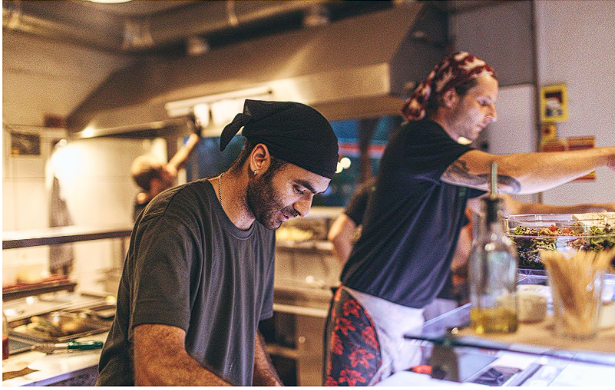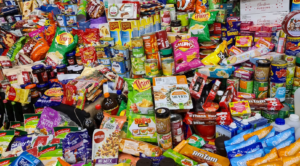- Food Startup Funding: Do you need investors to build a successful food or beverage business? - February 29, 2024
- Explaining Food Certifications & Labeling: Organing, Non-GMO, Halal, Kosher, & More! - February 29, 2024
- Explaining the Meaning of MOQ - February 29, 2024
Starting a food-based business is a challenging but rewarding venture. Whether you want to introduce new gluten-free products or jump on the cookie business trend, anyone can become a food entrepreneur. However, success does not come without communication, research, and hard work.
In an industry where 80% of all food startups fail, you’ll want to know what it takes to beat those odds. With the right mindset and strategies, you can build a successful brand. Today, we will discuss some ideas and tips for food entrepreneurs and startups to help you launch your business.
Who is Considered a Food Entrepreneur?
Food entrepreneurs are individuals who start and manage food-based businesses. Their primary goal is to develop innovative solutions for tackling the various complex challenges facing the food industry. They work hard to build companies that create and sell food products that cater to the needs and interests of customers.
Food entrepreneurs typically handle a range of responsibilities, including product development and testing of recipes and prototypes, as well as market and competition research. They may also be responsible for selecting suppliers for ingredients, finding manufacturers or packagers, identifying potential funding sources, and managing the day-to-day business operations.
Overall, food entrepreneurship involves being innovative, creative, and passionate about food. It’s a challenging yet exciting field that can require a lot of hard work and dedication to succeed.
Successful Food Entrepreneurs & Their Brands
A successful food entrepreneur or brand offers a unique or innovative product that meets the demands of its customers, is profitable, and has a broad reach in the market. These brands can significantly impact the food industry and shape our culture by changing the way people eat, think, and talk about food.
Defining the success of a food entrepreneur or brand varies depending on the intended audience or product’s scope, size, and demographics. For example, some brands may target a niche community or specialize in certain diets or allergens, while others cater to a broader mainstream audience.
Here are some examples of successful food entrepreneurs:
- Foodvisor: Founded by Charles Boes, Foodvisor is an innovative nutrition app that analyzes your meals and provides nutrition information through a photo. The app can also create a diet plan for you, and help you make healthy choices with coaching.
- Chef Avenue: Seema Shenoy had the idea to create cookware that is useful for prep & storage, and that can transition easily to the oven or microwave, eliminating the need for multiple pans, pots, and storage containers.
- Current Foods: Founded by Jacek Prus, Ron Shigeta, and Sonia Hurtado, Current Foods is a leader in the sustainability space. Their goal is to create healthy and delicious plant-based fish alternatives, fighting against overfishing and pollution of our oceans.
- Liquid Death: Founded by Mike Cessario, this brand is fighting plastic pollution by offering water in a can. A simple and ingenious idea, that keeps consumers coming back with its iconic branding.
- Olio: Tessa Clarke and Saasha Celestial-One aim to bring awareness to and fight the issue of food waste. Olio connects communities with local businesses that may have surplus food to sell at a discount.
Looking for the Perfect Co-packer For Your Brand?
Tips for Food Entrepreneurs & Startups
If you’re an aspiring food entrepreneur or startup owner, it’s helpful to be aware of the best practices to build your business.
1. Understand Your Product Requirements
While it’s great to have an exciting idea, you’ll need to know exactly what your food or beverage product will require to get from idea to shelf. Establish clear goals, such as its intended use, benefits, and price point. Define the specific attributes of the product, such as flavor, texture, packaging, and nutritional content. Make sure to consider:
- Will the product require special production equipment or processes?
- Is your aim to introduce an existing recipe into the market, or are you looking to sell under a private label?
- What ingredients do you need? Is there a reliable source for them?
- Will the production of the product require specialized labor?
- What are your packaging and labeling needs?
- Is this a specialty item, such as a gluten-free product, that has additional regulations and requirements?
All of these questions will guide you in determining whether your product is feasible and what steps to take to be successful.
2. Research the Market and Choose Your Niche
To stand out in a competitive marketplace, you need to research your competition and choose a niche that aligns with your values and goals. Perhaps your brand aims to promote a healthy lifestyle and provide food products that are organic and nutritious. Or maybe you want to be the face of your private label energy drink. The customers for each of these offerings are likely very different.
Conduct research to gain insights into the target market’s preferences, needs, and pain points. This can include analyzing industry reports, conducting surveys, and even focus groups if you have the opportunity. The research can help in identifying the competition and gaps in the market.
3. Recipe Formulation & Development
Food entrepreneurs often start with a recipe, but in order to scale a product, they must transform that recipe into a formula. This involves converting the recipe into precise measurements and ratios of ingredients, as well as establishing consistent cooking and processing methods. A formula is how a professional food manufacturer documents your information in pounds, kilograms, grams, or other weight measurements. These weights are then converted to relative percentages and used to make any amount or batch size of your product.
To create a formula, food entrepreneurs work closely with product development teams, which may include food scientists, research chefs, and food technicians. These experts can help to identify the optimal ingredients and ratios for the recipe, as well as suggest modifications that can improve the product’s taste, texture, and shelf life.
Throughout the process of transforming a recipe into a formula, food entrepreneurs must remain flexible and open to feedback and suggestions. This requires a willingness to experiment and adjust the formula until it meets the desired specifications and is ready for commercial production.
4. Find the Right Co-Manufacturer or Co-Packer
Once the formula is ready, food entrepreneurs must then find the right co-manufacturer to produce their product on a large scale. Co-manufacturers manufacture food or beverage products for other brands according to the brand’s instructions, while co-packers package finished or natural products. However, these terms can be used interchangeably and contract manufacturers often produce and package products.
It’s important to note that co-packers with turnkey services can start working with you as soon as you have a product idea. In turnkey manufacturing, a co-man can assume some or all responsibility for the entire manufacturing process of a product on behalf of their client, from development to production and finally to delivery.
So how do you find the right co-man with the services you need? The bad news: It can take months or years of research, cold-calling, interviews, site visits, and communication to even start working with a co-man. And then there’s no guarantee it’s the right fit.
The good news? PartnerSlate takes all of this work off your plate. PartnerSlate’s matching marketplace partners you with high-quality production partners from our extensive network of food and beverage manufacturers and packagers. How does it work?
- Create a profile and detailed project to give manufacturers the info they need to know if you’re a good match for their capabilities.
- List your project on PartnerSlate’s Marketplace and let qualified manufacturers come to you. Our network of nearly 6,000 co-mans is the largest anywhere.
- We’ll connect you with multiple manufacturers on our platform, which streamlines document sharing, communication, and onboarding–all in one place.
5. Find Funding (If Needed)
If you aren’t financing your food business startup on your own, then it’s likely you’ll need to find the capital to get off the ground.
While there are traditional funders for food entrepreneurs, such as banks and other financial institutions, these can be difficult to access without a track record of success or collateral. Therefore, many food entrepreneurs turn to alternative funding methods, like finding investors, to get their businesses off the ground.
Some options include:
- Approaching friends and family: Food entrepreneurs may turn to friends and family members to provide funding. This approach can be less formal than traditional funding methods and may involve loans, investments, or gifts.
- Crowdfunding: Crowdfunding has become a popular way for food entrepreneurs to raise funds. Crowdfunding platforms allow entrepreneurs to create a campaign and solicit contributions from the public in exchange for rewards or equity in the company.
- Angel Investors: Angel investors are individuals who invest their own money in early-stage startups in exchange for equity in the company. Many angel investors have experience in the food industry and can provide valuable expertise and connections.
- Venture Capital: Venture capital firms provide funding to startups in exchange for equity in the company. These firms typically invest in companies with high growth potential and a strong team.
- Grants: Food entrepreneurs may be eligible for grants from government agencies or non-profit organizations that support food-related businesses. These grants do not require repayment but may have specific eligibility criteria and reporting requirements.
Keep in mind that investors are looking to invest in businesses, not personalities, products, or ideas. Creating a business plan provides potential investors with an overview of your business and allows you to map everything out and identify weaknesses. Your business plan should detail your product, target market, cost estimates to get up and running, and sales projections.
6. Hire the Right Team
As an independent food entrepreneur, you need a team of skilled and dedicated professionals to help you run your business. Some roles to consider are:
- Product development
- Operations
- Marketing
- Sales
- Finance
- Quality control
In a startup, team members may wear multiple hats and take on multiple roles. However, covering these key areas is essential to building a successful food product startup.
7. Prioritize Branding & Marketing
To succeed in a crowded marketplace, branding, and marketing are key. Develop a brand identity that resonates with your target audience and create marketing strategies that communicate your unique value proposition.
Where do you start with developing a brand identity? Consider your product’s values, personality, and target audience. How would you communicate what your food product is about and what sets it apart from the competition? Your logo and company name should reflect that identity, and so should your packaging.
Once the branding is final, it’s time to spread the word about your product with an effective product description. Some methods to consider include developing a website to showcase your products, working on social media to build brand awareness and engage with customers, participating in events to get your product in front of potential customers and create buzz, and partnering with influencers such as food bloggers and other thought leaders in the industry to reach a wider audience and build credibility for your product.
8. Test Out Your Concept
Before launching your product, test it out in a controlled environment, such as a focus group or a pop-up restaurant. It’s also important to test your product including sensory evaluations (taste, texture, appearance, and overall acceptability), nutritional analysis, stability testing, and shelf-life studies.
This step will help you evaluate your product and make necessary improvements.
9. Evaluate & Improve
By conducting regular assessments and taking steps to improve their business, food entrepreneurs can stay competitive and continue to grow. Some specific actions that food entrepreneurs can take to evaluate and improve their business include :
- Product testing and feedback
- Cost analysis
- Regular sales and financial analysis
- Keep an eye on regulations
- Adapt or improve based on feedback
Implementing a continuous improvement program will keep you up-to-date with the ever-evolving food industry, improve quality and advance your business.
Scale Your Food Startup Journey with the Right CoPacker
Starting a food-based business is no easy feat. To be successful, food entrepreneurs and startups need to take an innovative approach and follow best practices to ensure sustainable growth. With the right co-packer, food companies can achieve a well-defined product with fast lead times.
Partnerslate is an excellent tool for entrepreneurs and startups looking to grow their businesses. Through the platform, food businesses can easily connect with contract manufacturers and co-packers, allowing food entrepreneurs to expand their product offerings and scale their businesses efficiently. Simply start by creating a profile and listing your project and we’ll connect you with a selection of manufacturers that could all be the perfect fit.
Explore Partnerslate today to maximize your food startup journey!



